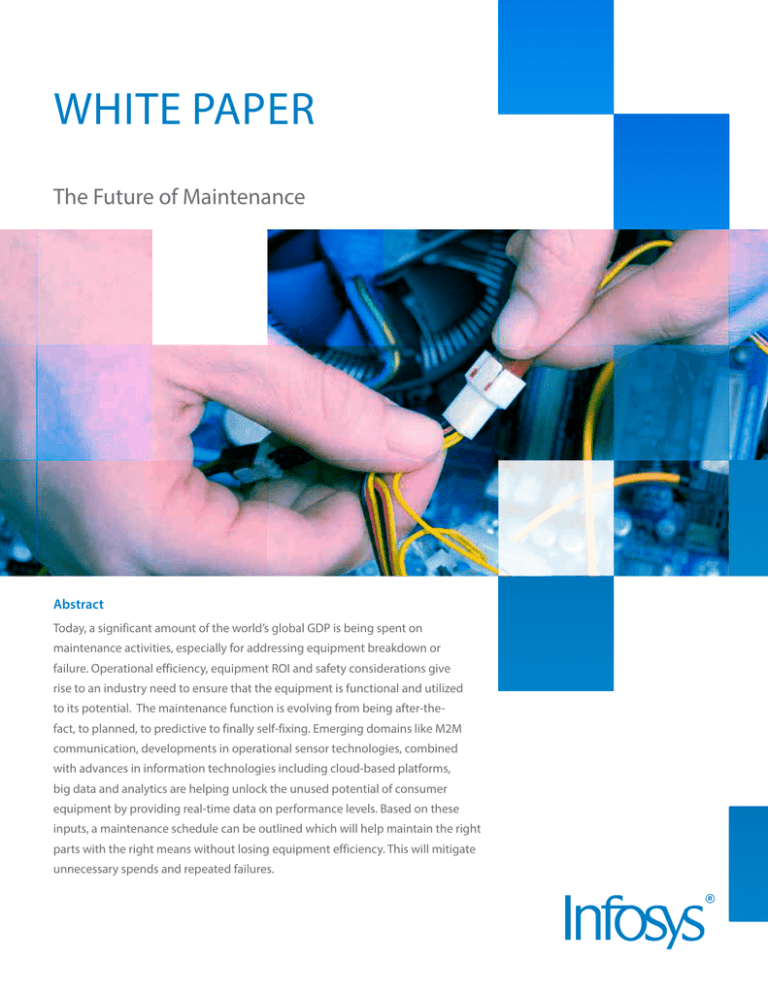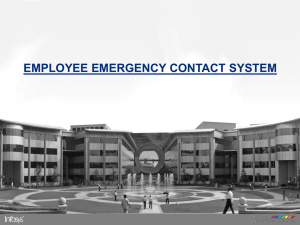
white paper
The Future of Maintenance
Abstract
Today, a significant amount of the world’s global GDP is being spent on
maintenance activities, especially for addressing equipment breakdown or
failure. Operational efficiency, equipment ROI and safety considerations give
rise to an industry need to ensure that the equipment is functional and utilized
to its potential. The maintenance function is evolving from being after-thefact, to planned, to predictive to finally self-fixing. Emerging domains like M2M
communication, developments in operational sensor technologies, combined
with advances in information technologies including cloud-based platforms,
big data and analytics are helping unlock the unused potential of consumer
equipment by providing real-time data on performance levels. Based on these
inputs, a maintenance schedule can be outlined which will help maintain the right
parts with the right means without losing equipment efficiency. This will mitigate
unnecessary spends and repeated failures.
A data-based approach is taking maintenance to the next level and ‘Maintenance-as-a-Service’ will soon become the order of the
day. This approach will allow equipment to be monitored and fixed remotely with a potential functionality to even heal itself. New
business models will emerge wherein a product will be sold not at a fixed price, but rather on the basis of the throughput it can
deliver in a given time. The manufacturers will take responsibility for the equipment and ensure that you get the most out of it while
they receive an annuity and additional business based on product and service quality. Total cost of ownership will soon take center
stage as the key measure of success.
In this paper we discuss the technologies to consider, their integration and the key considerations of such an initiative.
External Document
© 2014
Infosys Limited
External Document
© 2015 Infosys
Limited
Introduction
Loyal customers are the most sought
create a success story. Services will include
after assets that give your business a
technical support on product usage, supply
competitive edge. Winning customer
of consumables and maintenance services
loyalty for your product is exceptionally
which form the most significant portion
important in today’s competitive business
among the services provided.
environment and forms the core of most
business strategies. Producing classy and
efficient products is not enough; they
should be clubbed with performancebased services that bind customers into a
sustained relationship. These services must
be tightly integrated with the product
along with a robust support ecosystem to
operations.
Following an approach, based on heuristics
or standard guidelines, leaves behind
un-used potential of parts that still have
an amount of useful life remaining and
Maintenance services are critical as they
repeated maintenance service costs that
directly impact operational efficiency and
could be avoided. While this is known
equipment uptime. Organizations have
to the industry, the absence of a reliable
evolved their maintenance strategies
and affordable mechanism to predict the
from fixing broken equipment to planned
condition of the equipment has prevented
maintenance to following the product
them from adopting condition-based
vendor’s recommendations to ensure
or predictive maintenance to realize
maximum uptime and efficient asset
maximum value.
New products are complex and need specialized skills to maintain them
Today, equipment design leverages the
knowledge and the desire to get into
than on complex maintenance activities,
latest advances in technology to meet the
maintenance details. The maintenance
would find value in a maintenance-as-
tight quality and efficiency standards of an
of these assets at optimal operational
a-service offering. Newer technologies
ever-demanding operating environment.
efficiency levels is an important requisite
enable exactly such services, which may
This challenges ordinary users to acquire
for business success and continues to be a
be managed via a product vendor or
multidimensional equipment maintenance
challenge. Users, who would prefer to focus
specialized service provider.
capability comprising skills, tools, system
on solving core business problems, rather
External Document
© 2014 Infosys
Limited
External Document
© 2015
Infosys Limited
Emerging technologies have a lot to offer to the maintenance industry
Cloud-based Internet of Things (IoT)
and analytics services
process.
Forewarned is forearmed in maintenance.
is required for such manufacturing
While this may not be an immediate
Emerging technologies like the IoT
operations and the ability to predict
concern under normal circumstances,
can help product manufacturers build
potential faults or breakdowns will
based on condition data and usage
intelligent connected products with the
undoubtedly provide valuable insights
pattern, chances are that after
ability to continually monitor their own
which will help save on time and resources.
approximately two months this may start
condition and ensure that operational
By using smart sensors and on-board
affecting the equipment’s efficiency and
efficiency is above the threshold for
electronics that can communicate with
result in higher energy consumption.
optimum performance. The need for such
the manufacturer’s cloud-based analytics
Four months on it could start generating
analytics will lead to the creation of built-in
system, the product vendor would be
vibrations that may start damaging other
or service-based offerings, which predict
able to assess the working condition and
components and lead to potential failure.
a dip in efficiency and perform root cause
service requirements of equipment in
analysis to locate the components needing
advance. Routine replacement of parts as
service or replacement.
per scheduled maintenance cycles, such as
For example, in case of a food processing
plant that operates two shifts a day, the
only opportunity for maintenance is during
non-working hours and holidays. A snag
that halts production could mean wastage
A high degree of system reliability
once in two years, can be avoided as long
as the equipment functions at optimal
levels. This would result in higher uptime
of equipment and remarkable savings in
maintenance costs.
able to detect this anomaly and point out
to the component showing signs of wear.
These kinds of insights produced by the
combined use of operational knowledge,
sensors, embedded electronics and
analytics service, cloud based systems,
could help unlock huge unused potential.
In the example above, continuous
monitoring and timely notifications
generated by the system approximately
of a huge amount of in-process material,
Later, say at the end of 3 years of utilization,
two months ahead of time before
which occasionally, can result in further
when it actually starts indicating some
observing a drop in efficiency enabled
down time due to equipment cleaning
variation in the current consumption
extended use of the component for an
and re-starting the affected manufacturing
pattern the embedded sensors would be
additional year.
External Document © 2015 Infosys Limited
Additive manufacturing for product maintenance
Additive manufacturing can help produce
interpreting a 3D CAD model, constructing
parts just in time at a place where you
components by continuously depositing
need it. In a normal scenario, an oil
material in horizontal layers and fusing
exploration ship that needs a component
them together to build a whole part.
replaced while on a mission would have
A few promising advanced additive
Additive manufacturing allows production
to return to a port for repairs. But with
manufacturing techniques are 3D printing,
of parts on the go. Soon product
advanced manufacturing techniques,
laser sintering and stereo lithography.
vendors would sell 3D part specifications
the ship can produce parts on-board by
buying a license from the manufacturer to
create a replica over a cloud based service
and greatly reduce supply chain and
Broadly, an additive manufacturing process
has the following advantages:
1. Can produce parts on demand as it
eliminate the need for specialized skills.
Hence they are a versatile and acceptable
solution for several maintenance scenarios.
subject to appropriate digital rights, to
allow legitimate customers and service
technicians to buy/lease licenses for
printing a certain number of copies in
inventory carrying costs. Most companies
does not require molds, dies or preset
online marketplaces like app stores. This
in the EPC (Engineering Procurement and
tooling.
will build an ecosystem/marketplace where
Construction) sector derive substantial
2. Involves no setup cost for tooling,
product vendors and value-added service
benefits from IoT as supply chain and
hence can accommodate changes at
providers could offer digital versions
inventory carrying costs constitute a major
no additional cost.
of component specifications either in
part of their expenses that can be done
away with. Turn key projects executed
by EPC companies like commissioning
oil refineries, dams, bridges etc. can 3D
print components needed at site instead
of waiting for these parts to be procured
and shipped via the company’s preferred
vendors.
3. No minimum batch quantity; can
manufacture even a single piece.
4. Does not require an elaborate
types of equipment can operate in
food processing equipment’s service
offices, homes or even in maintenance
request is equipped with additive
technicians’ vans.
manufacturing systems inside the service
5. Can manufacture parts with different
unique technologies. Each additive
plastics to resins and metals.
But essentially, it follows a basic process of
In the earlier example, consider a scenario
in which the technician attending to the
materials ranging from polymers and
deposits material to build a part.
custom needs.
production environment, and many
Additive manufacturing leverages several
manufacturing process varies in the way it
standard designs or modified to suit
These advanced manufacturing techniques
not only impart the ability to produce parts
where and when required but also largely
van. The technician could print parts
before coming to the site or on arrival.
This would eliminate the lead time of
parts ordering and delivery, as well as
significantly shrink sourcing costs. In effect,
the only party involved in the supply chain
and repair job is the service technician.
External Document © 2015 Infosys Limited
New business models will evolve as a result of technology evolution
Companies will be able to exploit the
sell cars alone, but rather, a complete
equipment, such as 3D printers on which
advantages of the latest technologies
mobility solution for several years, and
they could receive printing instructions
to adopt new business models built
include the cost of peripheral services such
for parts based on the analytics and alerts
around deep analytical insights and new
as maintenance and insurance in the price.
received on cloud infrastructure from the
delivery mechanisms. This will shrink the
equipment installed at the customer’s
Such possibilities, which are entirely
organization’s size in terms of staff and
premises. Such a service model would
conceivable in the near future, will
physical infrastructure, and thereby save
not only allow the service provider to
change the way in which organizations
cost. Products will no longer be physical
take timely action but also engage the
look at clients and provide services. In
objects alone, but also include a service
customer in discussions to take feedback or
these scenarios, organizations would
component to comprehensively address
continually monitor assets, fine tune them
end user needs. For example, the sale of
washing machines may be replaced by the
sale of garment washing services at a fixed
cost and duration of say, 10 years.
Similarly, automobile companies will not
sell additional products.
over the network when needed, and keep
Compared to a conventional customer
customers posted. They might engage
service supply chain, these new models
local empaneled service technicians to
will require significantly fewer people and
provide services, enabling them with
lesser infrastructure to deliver similar or
information on service requests as well as
even superior services.
Customer identifies an issue and logs a service request
Local
Contracted
Agency
Maintenance
Technician
Back Office
Scheduling
Call Center
Representative
Maintenance technician’s first trip
Log part request +
schedule next
appointment
Suggest
service + part
replacement
Maintenance
Technician site
visit
Customer
Component Supply Chain
Supplier
OEM
Distributer
Warehouse
Retailer/
Channel
partner
Maintenance
Technician
Product
installed at
customer site
Maintenance technician’s second trip
Maintenance
Technician
Figure 1: Conventional Customer Service and Supply Chain Scenario for a Service
Sell product through different sales channels
Product
Vendor/
Original
Equipment
Manufacturer
(OEM)
Parts
digital
spec
Alerts, updates,
consolidated
view
Digital part spec
& standard
operating
procedures for
maintenance
Maintenance Service
Providers cloud service
CRM Services
Alerts, updates,
consolidated view
Monitoring Service
Monitoring and
Performance data
Field technician
management service
Alerts & Updates
Other Services
Local empanelled service
technician
Maintenance service at a
time convenient for
client & 3D printed parts
Client
Product
installed
at client
location
Figure 2: Futuristic, connected products talking to a cloud-based infrastructure to produce insights and a field technician who can fulfill the
need based on an online service request
External Document © 2015 Infosys Limited
Challenges
While new products will be designed
Though additive manufacturing can
considering what IoT has to offer, a
produce complex intricate parts
component specifications with
huge amount of existing assets needing
outside the capability of conventional
extreme details unlike conventional
maintenance will have to be retrofitted
manufacturing processes, it has its own
manufacturing processes. Product
with devices to get insights. This may not
drawbacks as well:
vendors will have to make significant
always be straightforward due to:
1. Inadequate detailed technical
knowledge about the equipment.
2. Selection of appropriate devices for
data acquisition.
3. The difficulty in devising IT systems and
cloud-based services for monitoring
equipment not designed from ground
1. Certain components are still
best produced by conventional
manufacturing processes. Examples
include:
a. Very strong components, such as
forgings, may require conventional
manufacturing.
b. Components that need very
up with monitoring integrated in the
high surface finishes are yet
basic design.
difficult to produce by additive
4. The need for proven analytics and
mathematical models to convert data
acquired into insights.
5. Down time involved in retrofitting and
monitoring assets before making them
available for production.
manufacturing.
c. Certain materials, such as wood,
2.Additive manufacturing requires
investments to produce these
specifications, before adopting
additive manufacturing as a mode of
component delivery.
3.Availability and cost constraints in
procuring industrial grade additive
manufacturing equipment.
Assets that are remotely located or operate
in very harsh environments may have
challenges in connecting with cloud-based
services. Examples include deep sea oil
rig equipment or mining equipment that
operate hundreds of feet underground.
can only be processed through
Special connectivity solutions will have to
conventional manufacturing
be designed and implemented for such
processes due to their inherent
applications.
properties/ limitations in printing.
External Document © 2015 Infosys Limited
Conclusion
Business models will transform from merely selling
products to offering an entire solution, complete with
product, usage options such as leasing, and sundry
business solutions, for a total cost of ownership till
the end of product life. Product vendors will focus
on their core strengths and build better products,
relying greatly or even totally on ecosystem partners
to provide additional services like maintenance, repair
and other support functions.
Leveraging technologies such as IoT, analytics,
sensing, additive manufacturing and others in new
product design will both be the norm and a factor
of success.
About the author
Mitesh Patel,
Group Project Manager – Manufacturing Innovation Initiatives, Manufacturing, Infosys
With over 15 years of industry experience, Mitesh leads the Internet of Things (IoT) domain for the Manufacturing Innovation
Initiative group. He works closely with clients and teams working on IoT programs, enabling development of merging
technology implementations, Machine-to-Machine (M2M) communication, and emerging technologies. Mitesh has also worked
in the areas of robotics and product development. Other areas that Mitesh focus on include enterprise application integration.
For more information, contact askus@infosys.com
© 2015 Infosys Limited, Bangalore, India. All Rights Reserved. Infosys believes the information in this document is accurate as of its publication date; such information is subject to change without notice. Infosys
acknowledges the proprietary rights of other companies to the trademarks, product names and such other intellectual property rights mentioned in this document. Except as expressly permitted, neither this
documentation nor any part of it may be reproduced, stored in a retrieval system, or transmitted in any form or by any means, electronic, mechanical, printing, photocopying, recording or otherwise, without the
prior permission of Infosys Limited and/ or any named intellectual property rights holders under this document.
Stay Connected




